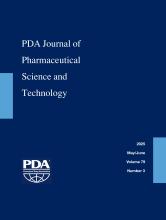Abstract
Many on-body delivery systems (OBDSs) for subcutaneous (SC) delivery require a change in primary container closure system (CCS). This necessitates compatibility and stability testing with original packaging materials and distribution and assembly, which are often laborious and time-consuming. Exploring new primary CCSs rather than using an original CCS can introduce risks, prolong timelines, and increase costs. In this study, 21 US-based combination product experts completed a double-blinded online survey between 6 October and 20 November 2023. The survey included 15 screening questions and 23 survey questions, including questions about compatibility issues between new CCSs and drugs and stability testing for new CCSs. The largest proportion of participants (28.6%) reported that 5-10% of products they had worked directly on had experienced compatibility issues between a new CCS and a drug, with a weighted average of 11.9%. The most common compatibility issues were particulate challenges in 55.6%, sterility in 27.8%, and leachables in 16.7%. Most respondents (76.2%) rated the timeline showing that using an OCC can save 12-24 months as somewhat (38.1%) or very (38.1%) representative. Most participants (57.1%) estimated that the range of direct costs, including development costs, drug product, engineering runs, line changes, and other costs, when using an OBDS with a new CCS is $1015 million, 38.1% estimated <$10 million, and 4.8% estimated $2125 million. Most participants (80.9%) reported that challenges in the primary CCS qualification/validation process delay entry of combination products into clinical trials or delay their commercial launch. The weighted average of the delay was 9.7 months. Using an original CCS during combination product development would therefore be of significant economic benefit to the development of combination products in terms of time, cost, and risk.
- Received January 7, 2025.
- Revision received April 23, 2025.
- Accepted May 22, 2025.
PDA members receive access to all articles published in the current year and previous volume year. Institutional subscribers received access to all content. Log in below to receive access to this article if you are either of these.
If you are neither or you are a PDA member trying to access an article outside of your membership license, then you must purchase access to this article (below). If you do not have a username or password for JPST, you will be required to create an account prior to purchasing.
Full issue PDFs are for PDA members only.
Note to pda.org users
The PDA and PDA bookstore websites (www.pda.org and www.pda.org/bookstore) are separate websites from the PDA JPST website. When you first join PDA, your initial UserID and Password are sent to HighWirePress to create your PDA JPST account. Subsequent UserrID and Password changes required at the PDA websites will not pass on to PDA JPST and vice versa. If you forget your PDA JPST UserID and/or Password, you can request help to retrieve UserID and reset Password below.






